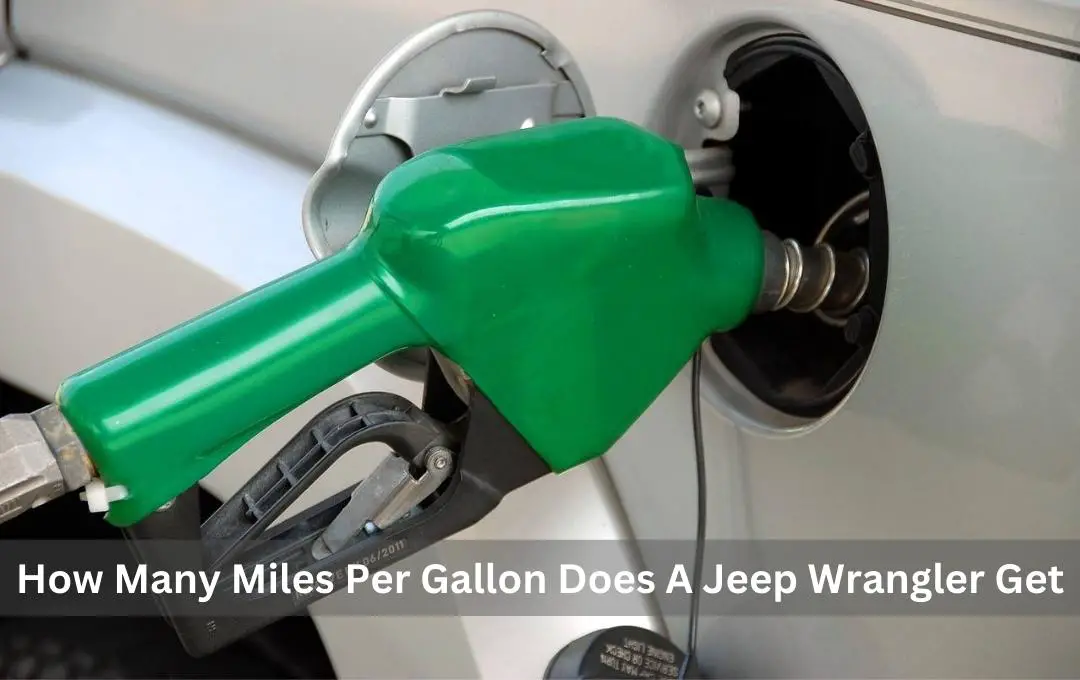How Many MPG Does Jeep Wrangler Get: A Comprehensive Guide to Fuel Economy
How Many MPG Does Jeep Wrangler Get: A Comprehensive Guide to Fuel Economy jeeps.truckstrend.com
The Jeep Wrangler, an undisputed icon of adventure and off-road capability, holds a special place in the hearts of enthusiasts worldwide. With its distinctive grille, removable doors, and legendary go-anywhere attitude, it’s a vehicle built for exploration, not necessarily for miserly fuel consumption. However, for many prospective buyers and current owners, the question of "How many MPG does a Jeep Wrangler get?" remains a crucial consideration. Understanding its fuel economy is vital for budgeting, planning long trips, and even making an environmentally conscious choice.
This comprehensive guide will delve deep into the various factors that influence a Wrangler’s MPG, from its engine options and historical evolution to real-world driving conditions and actionable tips for maximizing efficiency. While the Wrangler may never compete with a hybrid sedan in terms of miles per gallon, recent innovations have made significant strides in improving its efficiency without compromising its rugged spirit.
How Many MPG Does Jeep Wrangler Get: A Comprehensive Guide to Fuel Economy
Historical Context: A Look Back at Wrangler MPG
To appreciate the current state of Wrangler fuel economy, it’s helpful to understand its journey. For decades, the Wrangler (and its predecessors like the CJ) prioritized durability, simplicity, and off-road prowess over fuel efficiency.
- Early Generations (YJ, TJ): These models, typically equipped with inline-four or inline-six engines, delivered MPG figures that were, by modern standards, quite low. You might see combined averages in the low to mid-teens (13-16 MPG), depending heavily on the engine, transmission, and modifications.
- JK Generation (2007-2018): The introduction of the 3.6L Pentastar V6 in 2012 marked a noticeable improvement. This engine offered more power and better efficiency than its predecessors, pushing combined MPG figures into the high teens (17-19 MPG) for the Unlimited (4-door) models and slightly better for the 2-door. While not groundbreaking, it was a step in the right direction.
The consistent theme throughout the Wrangler’s history has been its brick-like aerodynamics, heavy-duty components, and focus on capability, all of which inherently work against optimal fuel economy.
Current Generation (JL) Powertrains and Their MPG

The current JL generation of the Jeep Wrangler, introduced in 2018, offers a more diverse range of engine options, significantly impacting fuel economy. Each powertrain is designed to cater to different needs, from raw power to surprising efficiency.
Here’s a breakdown of the primary engine options and their EPA estimated MPG figures for the 2023/2024 models:
-
3.6L Pentastar V6 (Standard):

- 2-door: 17 City / 23 Highway / 19 Combined MPG (Manual)
- 2-door: 19 City / 24 Highway / 21 Combined MPG (Automatic)
- 4-door (Unlimited): 19 City / 24 Highway / 21 Combined MPG (Automatic)
- This engine remains a popular choice, offering a good balance of power and a respectable (for a Wrangler) fuel economy. The automatic transmission typically provides slightly better highway figures due to optimized gearing.

-
2.0L Turbo I4 Engine:
- 2-door: 21 City / 24 Highway / 22 Combined MPG (Automatic)
- 4-door (Unlimited): 21 City / 24 Highway / 22 Combined MPG (Automatic)
- This turbocharged four-cylinder engine offers comparable horsepower to the V6 but significantly more torque at lower RPMs, making it feel punchier. It also boasts slightly better fuel economy, particularly in city driving, thanks to its smaller displacement and turbocharging.
-
3.0L EcoDiesel V6 (Discontinued for 2024+ Models, but relevant for used market):
- 4-door (Unlimited): 22 City / 29 Highway / 25 Combined MPG (Automatic)
- For those seeking maximum torque for towing or serious off-roading, the EcoDiesel was a powerhouse. It also offered the best conventional fuel economy of any Wrangler, especially on the highway. Its discontinuation means it will primarily be found in used JL models.
-
2.0L Turbo I4 with Plug-in Hybrid (PHEV) – The Wrangler 4xe:
- 4-door (Unlimited): 49 MPGe (Miles Per Gallon equivalent) Combined
- Total Range: 370 miles
- Electric Only Range: 21-22 miles (depending on year/trim)
- The 4xe is the game-changer for Wrangler fuel efficiency. It combines the 2.0L turbo engine with two electric motors and a 17 kWh battery pack. For short commutes and city driving, it can operate solely on electric power, offering significant fuel savings. When the battery is depleted, or more power is needed, the gasoline engine kicks in. The 49 MPGe figure reflects its efficiency when utilizing both electricity and gasoline.
-
6.4L HEMI V8 (Rubicon 392):
- 4-door (Unlimited): 13 City / 17 Highway / 14 Combined MPG (Automatic)
- The Rubicon 392 is built for raw performance and off-road speed, not fuel economy. Its powerful V8 engine delivers exhilarating acceleration but comes with the expected trade-off in fuel consumption.
Factors Influencing Real-World Wrangler MPG
While EPA estimates provide a baseline, real-world Wrangler MPG can vary significantly due to numerous factors. Owners often report figures lower than the official estimates, particularly given how Wranglers are frequently used and modified.
- Driving Style: Aggressive acceleration, hard braking, and high speeds are MPG killers for any vehicle, especially a non-aerodynamic one like the Wrangler. Smooth, consistent driving with gentle inputs can significantly improve efficiency.
- Terrain and Conditions:
- Off-roading: Engaging 4WD, crawling over obstacles, and driving on soft surfaces (sand, mud, deep snow) dramatically increases fuel consumption.
- Hills and Mountains: Climbing inclines requires more power and thus more fuel.
- Headwinds: Fighting strong headwind creates significant aerodynamic drag, reducing MPG.
- Vehicle Configuration and Weight:
- 2-door vs. 4-door: The lighter 2-door typically gets slightly better MPG than the heavier 4-door Unlimited.
- Hardtop vs. Soft Top: While subtle, the hardtop generally offers better aerodynamics and insulation, potentially leading to marginal improvements over a soft top.
- Aftermarket Modifications: This is a major factor.
- Larger/Heavier Tires: Aggressive, larger-diameter off-road tires increase rolling resistance and unsprung weight, significantly hurting MPG.
- Lift Kits: Lifting the vehicle increases its frontal area and disrupts airflow, leading to more aerodynamic drag.
- Heavy Bumpers, Winches, Roof Racks, Skid Plates: All add significant weight, requiring more fuel to move the vehicle. Roof racks also create considerable drag.
- Gearing Changes: If larger tires are installed without re-gearing the axles, the engine will operate outside its optimal RPM range, reducing efficiency.
- Maintenance:
- Tire Pressure: Under-inflated tires increase rolling resistance.
- Engine Tune-up: A well-maintained engine (clean air filter, proper spark plugs, fresh oil) runs more efficiently.
- Fluid Levels: Correct fluid levels and types ensure components operate optimally.
- Weather Conditions: Cold weather can reduce fuel economy as engines take longer to warm up, and fuel is denser. Air conditioning use in hot weather also draws power from the engine.
Tips for Maximizing Your Wrangler’s Fuel Economy
While a Wrangler won’t ever be a fuel sipper, you can take steps to improve its efficiency:
- Maintain Proper Tire Pressure: Check your tire pressure regularly and keep it at the manufacturer’s recommended PSI. This is one of the easiest and most effective ways to save fuel.
- Practice Smooth Driving Habits: Avoid aggressive acceleration and sudden braking. Anticipate traffic and coast to stops when possible. Maintain a consistent speed on highways.
- Remove Unnecessary Weight: Take out anything you don’t need in the cargo area. Every extra pound costs fuel.
- Minimize Aerodynamic Drag:
- Remove roof racks, bike carriers, or other external accessories when not in use.
- Consider the impact of aftermarket accessories like light bars and large, non-aerodynamic bumpers.
- Perform Regular Maintenance: Follow Jeep’s recommended service schedule. A well-tuned engine is an efficient engine.
- Plan Your Routes: Combine errands, avoid peak traffic times, and use navigation apps to find the most efficient routes.
- Consider Tire Choice: If off-road capability isn’t your primary concern, consider less aggressive (and often lighter) all-terrain or street-oriented tires, which have lower rolling resistance.
- Utilize Overdrive (if applicable): Use the highest gear available on the highway to keep RPMs low.
- For 4xe Owners: Charge Regularly! To maximize your MPGe, plug in your 4xe whenever possible. Short commutes can be almost entirely electric, saving significant amounts of gasoline.
Wrangler 4xe: The Game Changer for MPG
The introduction of the Wrangler 4xe marked a significant shift in the narrative around the Wrangler’s fuel economy. It’s not just a hybrid; it’s a plug-in hybrid. This means it can be charged from an external power source, allowing for a substantial all-electric driving range (around 21-22 miles) before the gasoline engine even needs to kick in.
For owners with short daily commutes or those who primarily drive in the city, the 4xe can be incredibly fuel-efficient, potentially using very little gasoline for weeks if charged consistently. When the battery depletes or on longer trips, it functions as a traditional hybrid, still offering better fuel economy than its non-hybrid counterparts. The 49 MPGe rating is a testament to its ability to leverage electric power for efficiency gains. This innovation makes the Wrangler a viable option for those who want its iconic capability but are also mindful of their environmental footprint and fuel costs.
Is Low MPG a Deal Breaker for the Wrangler?
For many, the answer is a resounding "no." The Jeep Wrangler is rarely purchased for its fuel economy. Buyers are drawn to its:
- Unparalleled Off-Road Capability: It’s designed to conquer trails, rocks, and mud that would stop most other vehicles.
- Iconic Design and Heritage: The Wrangler’s unique, instantly recognizable look and deep roots in automotive history are powerful selling points.
- Open-Air Freedom: Removable doors, tops, and a fold-down windshield offer an unmatched driving experience.
- Strong Resale Value: Wranglers tend to hold their value exceptionally well.
- Customization Potential: The aftermarket for Wranglers is enormous, allowing owners to personalize their vehicles endlessly.
While fuel costs are a factor, Wrangler owners often prioritize these unique attributes over miserly fuel consumption. The availability of the 4xe model, however, offers a compelling solution for those who want the Wrangler experience with significantly improved efficiency, bridging the gap for a wider audience.
Wrangler MPG Comparison Table (EPA Estimates)
This table provides a snapshot of estimated EPA combined MPG figures for various 2023/2024 Jeep Wrangler models and powertrains. Real-world results may vary.
| Model/Powertrain | Transmission | Configuration | Combined MPG (EPA Est.) | Notes |
|---|---|---|---|---|
| 3.6L Pentastar V6 | Manual | 2-door | 19 MPG | Standard engine, classic choice |
| Automatic | 2-door | 21 MPG | Slightly better highway MPG with auto | |
| Automatic | 4-door (Unlimited) | 21 MPG | Most common configuration | |
| 2.0L Turbo I4 | Automatic | 2-door | 22 MPG | Good low-end torque, slightly better MPG |
| Automatic | 4-door (Unlimited) | 22 MPG | Efficient for its power | |
| 3.0L EcoDiesel V6 | Automatic | 4-door (Unlimited) | 25 MPG | Best conventional MPG (Discontinued) |
| 2.0L Turbo I4 (4xe PHEV) | Automatic | 4-door (Unlimited) | 49 MPGe | Best overall efficiency, 21-22 EV miles |
| 6.4L HEMI V8 (Rubicon 392) | Automatic | 4-door (Unlimited) | 14 MPG | High performance, lowest MPG |
Note: MPGe (Miles Per Gallon equivalent) for the 4xe factors in electricity consumption. Actual gasoline MPG will vary based on charging habits and electric-only driving.
Frequently Asked Questions (FAQ)
Q: Is the Jeep Wrangler a gas guzzler?
A: Compared to most modern passenger cars and SUVs, yes, traditional gasoline Wranglers do have lower MPG figures. However, with the introduction of the 4xe plug-in hybrid, it can be remarkably fuel-efficient for daily driving if charged regularly.
Q: Which Wrangler engine gets the best MPG?
A: The Wrangler 4xe (plug-in hybrid) gets the best "MPGe" (49 MPGe) due to its electric driving capability. Among conventional gasoline engines, the 2.0L Turbo I4 generally offers slightly better combined MPG than the 3.6L Pentastar V6, while the now-discontinued 3.0L EcoDiesel offered the best conventional MPG.
Q: Does lifting a Wrangler affect MPG?
A: Absolutely. Lifting a Wrangler increases its frontal area and disrupts airflow, leading to more aerodynamic drag. This, combined with larger, heavier tires that often accompany a lift, can significantly reduce your MPG.
Q: Is the 4xe really fuel-efficient?
A: Yes, if you utilize its plug-in hybrid capabilities. For short commutes (within its 21-22 mile electric range), you might use very little gasoline. Even after the battery is depleted, it functions as a traditional hybrid, offering better MPG than non-hybrid Wranglers.
Q: How much does off-roading impact MPG?
A: Off-roading can dramatically decrease MPG. Driving in 4WD, low gears, over uneven terrain, through mud or sand, and at low speeds all require more engine power and reduce efficiency significantly.
Q: Are manual Wranglers more fuel-efficient than automatics?
A: For the 3.6L Pentastar V6, the automatic transmission actually offers slightly better EPA highway and combined MPG ratings than the manual due to its additional gears and optimized shifting. For other engines, only automatic options are available.
Conclusion
The question of "How many MPG does a Jeep Wrangler get?" is complex, with answers varying widely depending on the specific model, engine, modifications, and driving habits. While traditionally known for their lower fuel economy, the latest generation Wranglers, particularly with the innovative 4xe plug-in hybrid option, are challenging that perception.
Ultimately, choosing a Jeep Wrangler is often about prioritizing capability, adventure, and an iconic lifestyle over pure fuel efficiency. However, understanding the factors that influence its MPG and implementing smart driving practices can help maximize your miles per gallon, ensuring your legendary off-roader remains ready for whatever adventure lies ahead, without breaking the bank at the pump quite as often.






